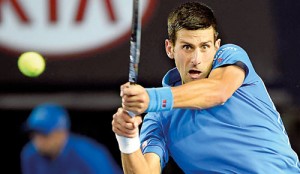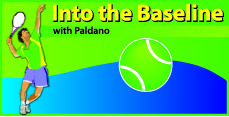Man for all surfaces – Djokovic
Roger Federer’s domination in Tennis is historic. So far, in the last two years, only one player has been good to score consistent wins against Federer and that is Serbia’s Novak Djokovic. This year, Djokovic has already won the Australian-Open and the first three ATP 1000 which proves remarkable consistency at the highest of levels.
From the 80’s the successive line up of John McEnroe, Jimmy Connors, Andre Agassi and Pete Sampras occupying the top slots of men’s Tennis put us in a groove to look for a another player from the USA.
The player who broke this trend is Switzerland’s Roger Federer. Ever since then and after the Eastern Europe’s entry into the Tennis world, it is difficult to spot the Americans in the semi-finals and finals in major tournaments.
In July 2014, Djokovic became the world’s number one and looks like he will be there at the end of this year too. As things stand, Djokovic is a prospect to achieve the Grand-Slam this year, breaking the 46-year-old-jinx as the last Grand-Slam was won by Australia’s Rodney (Rod) George Laver in 1969. It will not be easy for Djokovic but to me, it looks possible.
What is Djokovic’s specialty?
He does not win his tough matches too easily. While many a players are known for their ‘weapons’ Djokovic cannot be identified for any strokes as his weapon. It takes a while to find the reason why he wins. Anyone playing him will find him to be a ‘puzzle’ due to his adaptability to challenges, ability to cover every part of the court, sustain speed and produce boundless variations. It will place any opponent in ‘a cat on a hot tin roof’ situation.
Counter punching is a tactic of reaching and returning all the shots including the opponent’s attacks, with much venom. In my analysis, this is Djokovic’s base and his favourite. This is understandable as his development was on the sand court. What makes him special in doing this is his ability to adapt to any surface extremely well and progressively increasing pace as the rally progresses.
He ‘punishes’ most of opponents with this and makes them look like struggling juniors. He is also a master of the ‘Chameleon act’ in camouflage. This is why he could be seen up at the net in the most unexpected of moments.Cross training in development
Djokovic’s background most likely is from multiple-sport cross training. He has the athletic sprint to cover court; footballers’ balance in the execution of the stroke; Table Tennis player’s eye for ball contact; Badminton player’s ability in reading the shuttle early; and racquet handling ability of Squash players. No one has out lasted him this year in endurance/efficiency combination. In the last finals he played in Monte Carlo,  Czech Republic’s Tomas Berdych stood up very well but was unable to withstand the pace that Djokovic maintained in the finishing stages of the match. Berdych lost a tired man.
Czech Republic’s Tomas Berdych stood up very well but was unable to withstand the pace that Djokovic maintained in the finishing stages of the match. Berdych lost a tired man.
Federer described Djokovic to be a 100 per cent man on the court. This is true. Even when he is losing he never stops trying. This is how he beats second best clay court specialist Spain’s David Ferrer. Tactically, this gives the ‘creeps’ to any opponent. Tennis is played without a time-limit and Djokovic has, in very many instances, turned the tide to his favour with his ‘never say die’ attitude. At present Djokovic is the fiercest competitor in Tennis.
Height of adaptability
If I am to pin-point why Djokovic wins, I would say, his adaptation to court surfaces. When the surfaces change players also have to alter every aspect of the game – from thought, shot section, movement, tactics and game plan. This year, Djokovic won USA’s Indiana Wells and Miami on high bouncing very fast hard courts. Then came to Monte Carlo and won convincingly on the slow, low bouncing clay within a span of one week. This has to be considered the height of adaptability and not easy at all.In the sixties in Calcutta, the Indian Tennis stalwart Sumant Misra ‘pulled up’ his son Gaurav Misra, a good grass court player, for losing to a player on Catcutta South Club’s Grass courts. His opponent had just played his last tournament on clay. Sumant Misra commented that the first set any player playing on grass after a clay tournament, will take him out of ball orientation completely and was disappointed that his son did not exploit it.
This is true, when the surface changes, players will be searching the ball for a contact. In such situations, foot-work and stroke-making of players will hinder and limit shot section inefficient levels.
In world ranking Tennis, surface change adaptability is no easy task. This week in Istanbul, Federer registered only his 200th clay court win. This is extremely low for a maestro who has dominated the game for ten long years. Most of Federer’s losses have been on clay. Djokovic’s adaptability to surfaces will marvel any experienced player.
Djokovic tactics
Djokovic varies his serve according to the surface and registers an average of 70 per cent on his first serve. So there is very little or nothing left for opponents to exploit. His return of serve is most feared by opponents. They are lethal on all surfaces. When serving to Djokovic, opponents will run out of ideas very quickly and could choke.
To out-run Djokovic by placement is very risky, because of his speed of movement. Opponents will have to risk selecting court edges to place the ball which will increase the unforced-error rate. Having a large comfort-zone in coordination and timing Djokovic will punish the opponents with winners, if he is not moved and displaced effectively. It is like a ‘walk on high-wire’ for any player doing that to Djokovic. His back-hand down-the-line is known for its ‘killer’ power and placement.
French Open ‘warm-ups’
Predictably, Djokovic will even-out his losses with Roger Federer very soon. Istanbul is the new inclusion into the already crowded French-Open ‘warm ups’ run. Multiple venues in a week are making elite players scatter. ‘Warm-ups’ in Monte Carlo, Barcelona, Rome, Madrid and Istanbul look like ‘Tour de Europe’ in Tennis. I wonder how many will arrive fresh in Paris? They are all on European red clay. Djokovic’s home surface!
George Paldano, former international player;
Accredited Coach of Germany, National coach, Davis Cup and Federation Cup Coach; ITF and USPTR;
–gptennis.
ceylon@gmail.com


